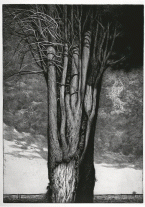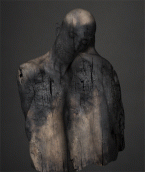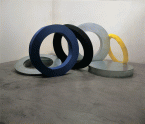About exhibition:
The idea of bringing together three artists, with diverse characters, and very different approaches to their work, dissimilar forms of expression and even understanding of art, but with a shared location of habitat, i.e. in the vicinity of a border, led us to contemplate whether we can compare them and find a shared tension within them and their work, i.e. a desire to see further, beyond the border, which all three artists see as a challenge and thus a reason to expand rather than restrict.
The work of each one of these three artists was juxtaposed in relation to the border on numer- ous occasions: in his text on France Dugo’s work Marco Goldin mentioned ‘the border as an existential state’; in his thoughts on the artistic development of Giorgio Valvassori, Giorgio Bonomi stated that ‘living and working in an area close to the border has strongly marked his work and life’; in an interview Roberto Kusterle stated that the space in which he lives is important, and he spoke about the ‘strong Central European heritage, a certain type of vision, the use of thick black [...]. The history still runs through our veins’.
The story of France Dugo starts with inspiration from the east. At the beginning of his painting and engraving career the painter and graphic artist Jiří Anderle was as much in the artist’s thoughts as Rembrandt. Dugo admires the precision and the callousness of the line with which the Czech artist explored the darkest sides of humanity in a dimension beyond time, and his boldness, with which he revealed the truth in a surrealist manner and without any censorship, which can be unpleasant to say the least. In Rembrandt’s works he observed the technique, the masterful game of light and shadows, the capability of descending deep into the human psyche, all of which Dugo repeated in his work, starting with self-portraits, which have been registering the passing of time throughout his life.
The photography in the work of Robert Kusterle is a means that erases all borders between truth and pretence and mixes them so they can no longer be distinguished; it becomes impos- sible to say what is real and what is not, as everything has been changed into what could have been. The technique and the contents represent the red thread that connects the work from the previous years with his newest works: the artist shows continuous interest in the relation- ship between man and nature. Nature finds the artist almost by chance as he strolls along the seashore or along a river embankment. In this case nature is represented by the soil, water, stones and everything that is moved, shaped and changed by water as these changes in the form inspire new worlds and new stories.
Giorgio Valvassori offers a game of opposites, for which he chooses elements, materials and forms that are linked to the essence of geometry and space, fabric and wood, iron and lead. The forms call into mind situations, the objects interact with the space and the viewer, the sculptures and installations encourage a different perception, which destabilises the mind by contrasting the appearance of everyday reality and playing with antimonies, irony and drama, lightness and heaviness, the concept and materiality, with ambiguity in general.
Franca Marri (from the catalogue to the exhibition)





